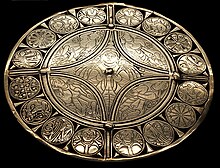| Fuller Brooch | |
|---|---|
 Fuller Brooch as displayed in the British Museum | |
| Material | Silver and niello |
| Size | 11.4 cm in diameter |
| Created | Late 9th Century AD |
| Present location | British Museum, London |
| Registration | M&ME 1952,0404.1 |

The Fuller Brooch is an Anglo-Saxon silver and niello brooch dated to the late 9th century, which is now in the British Museum, where it is normally on display in Room 41.[1] The elegance of the engraved decoration depicting the Five Senses, highlighted by being filled with niello, makes it one of the most highly regarded pieces of Anglo-Saxon art.
- ^ David Mackenzie Wilson (1964), Catalogue of antiquities of the later Saxon period, British Museum, OCLC 610435306,
The brooch's history (as recounted by Bruce-Mitford) is that it was bought from a London bric-à-brac dealer by an unnamed man who did not know its history, he passed it to Sir Charles Robinson who published it in 'The Antiquary'. A few years later Mr. E. Hockliffe, the son-in-law of Sir Charles Robinson, offered the brooch as a loan to the Ashmolean Museum, Oxford. E. T. Leeds, then an assistant at the museum, persuaded the then keeper D. G. Hogarth to accept the loan. On the advice of the then Keeper of British and Medieval Antiquities at the British Museum (Sir Hercules Read, P.S.A.) and his assistant keeper (R. A. Smith) the brooch was pronounced a fake and withdrawn from exhibition with the approval of the Ashmolean Museum's technical specialist, W. H. Young. The brooch was eventually purchased by Capt. A. W. F. Fuller and, apart from occasional mentions (e.g. by Sir Alfred Clapham), was not thought of seriously until the Strickland brooch (registration no. 1949,0702.1) was brought to the British Museum. On the advice of Sir Thomas Kendrick the Fuller brooch was traced by Mr. Bruce-Mitford and after laboratory examination it was acquired by the British Museum.